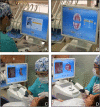Comparison of digital and conventional impression techniques: evaluation of patients' perception, treatment comfort, effectiveness and clinical outcomes
- PMID: 24479892
- PMCID: PMC3913616
- DOI: 10.1186/1472-6831-14-10
Comparison of digital and conventional impression techniques: evaluation of patients' perception, treatment comfort, effectiveness and clinical outcomes
Abstract
Background: The purpose of this study was to compare two impression techniques from the perspective of patient preferences and treatment comfort.
Methods: Twenty-four (12 male, 12 female) subjects who had no previous experience with either conventional or digital impression participated in this study. Conventional impressions of maxillary and mandibular dental arches were taken with a polyether impression material (Impregum, 3 M ESPE), and bite registrations were made with polysiloxane bite registration material (Futar D, Kettenbach). Two weeks later, digital impressions and bite scans were performed using an intra-oral scanner (CEREC Omnicam, Sirona). Immediately after the impressions were made, the subjects' attitudes, preferences and perceptions towards impression techniques were evaluated using a standardized questionnaire. The perceived source of stress was evaluated using the State-Trait Anxiety Scale. Processing steps of the impression techniques (tray selection, working time etc.) were recorded in seconds. Statistical analyses were performed with the Wilcoxon Rank test, and p < 0.05 was considered significant.
Results: There were significant differences among the groups (p < 0.05) in terms of total working time and processing steps. Patients stated that digital impressions were more comfortable than conventional techniques.
Conclusions: Digital impressions resulted in a more time-efficient technique than conventional impressions. Patients preferred the digital impression technique rather than conventional techniques.
Figures


References
-
- Mormann WH, Brandestini M, Lutz F. The Cerec system: computer-assisted preparation of direct ceramic inlays in 1 setting. Quintessenz. 1987;38:457–470. - PubMed
-
- Luthardt R, Weber A, Rudolph H, Schone C, Quaas S, Walter M. Design and production of dental prosthetic restorations: basic research on dental CAD/CAM technology. Int J Comput Dent. 2002;5:165–176. - PubMed
-
- Otto T, Schneider D. Long-term clinical results of chairside CEREC CAD/CAM inlays and onlays: a case series. Int J Prosthodont. 2008;21(1):53–59. - PubMed
-
- Wiedhahn K, Kerschbaum T, Fasbinder DF. Clinical long-term results with 617 CEREC veneers: a nine-year report. Int J Comput Dent. 2005;8:233–246. - PubMed
Publication types
MeSH terms
Substances
LinkOut - more resources
Full Text Sources
Other Literature Sources
Medical

